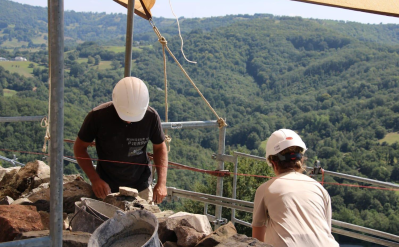
Building site at Château de Calmont d'Olt
Take part in the restoration of the Château de Calmont d'Olt at the heart of a European project. The heritage site The activities will take place in Espalion, a village in the...
In 1986, the Château de Calmont d'Olt, a feudal ruin overlooking the town of Espalion, was purchased by an old stone enthusiast. At his request, and to protect it from developers, the château was awarded the title of Classified Historic Monument.Over the next 12 years, a heritage education project with medieval activities was launched, as well as numerous clearing, clearing and stabilization projects involving a group of friends and a large number of scouts.
In 1997, André Châtelain, Honorary President of REMPART, who had come to visit Calmont d'Olt, offered us the chance to join the REMPART association. This was the turning point that enabled us to enter into the dynamic of international volunteer workcamps.
The association was created in 1998; the members already existed (the band of friends), they took over the owner's project by means of an emphyteutic lease, and the articles of association were filed with the object: "To study, develop, restore and promote the Château de Calmont d'Olt, with a view to safeguarding and conserving it.
Since then, restoration work has been carried out every summer under the aegis of REMPART, clearing the castle of the archaeological fill that encumbers it, cutting the stone, masonry and stabilizing the cleared walls, identifying the architecture that now appears to us.ological fill, cutting the stone, masonry and stabilizing the cleared walls, identifying the architecture that appears. This helps us to better understand the history and function of this medieval fortress.
The pedagogical project has evolved, and we're working on raising awareness of history and heritage among young audiences through a playful approach, interpretation circuits, medieval activities, educational workshops, heritage classes and archaeological exhibitions.
From its inception in 1986, the Calmont d'Olt conservation initiative has had a pedagogical dimension, with the owner's passion for architectural interpretation being seen as a means of transmitting his passion by interpreting the functions of these old stones.
The aim was to raise public awareness and interest in the theme. A medieval castle is often the illustration of a defense system, but how were these castles attacked?
Astonished by the technologies developed, but detached from all warmongering, we studied and illustrated the techniques of siege and warfare in the Middle Ages, with a particular focus on the 15th century, the last great architectural upheaval of the Middle Ages due to the advent of gunpowder.In Calmont d'Olt, the last great architectural upheaval of the Middle Ages, due to the advent of gunpowder, saw the construction of a low enclosure with 8 towers open at the throat and 32 cannonier crossbow arches.
It's no longer just a question of putting up stone walls, as the restoration project has become a human project, and if many volunteers, each having participated in their own way, come back and get involved, it's because they've found a place and people with whom they can share these values.Above all, the aim of our project is to save and safeguard a site that bears witness to our collective history, to the know-how and way of life of our ancestors.
Our volunteer workcamps are an exchange of good practices. Each participant gives of his or her time, and our role as supervisors is certainly to guide them (to avoid rebuilding a sandcastle), but above all to share and pass on ancestral know-how. Man has been cutting stone for more than 4,000 years, but today he has found faster ways of drowning the world in concrete, and know-how is gradually disappearing. Our aim is to pass on these skills to as many people as possible, for they are an integral part of our heritage.
Some of our volunteers have gone on to become stonemasons or carpenters, while others have turned to professions that protect our built heritage.
Our worksites become the stage for another kind of transmission: that of human and social values.
Our workcamps are aimed at all kinds of people, including the most isolated. Through partnerships with organizations such as local missions, children's homes and asylum seekers' centers, we have welcomed young people in difficulty or from "difficult" neighborhoods, as well as asylum seekers, and for many years we have had the status of "integration worksite" to enable everyone to discover an environment, trades and, why not, to envisage a professional horizon or a passion. For some, it's just an opportunity to bounce back from difficulties along the way. When setting up our groups, we give priority to a social and generational mix as far as possible, so that our workcamp becomes a meeting place for people who, in our society, don't have the opportunity to talk to each other or share a common effort on a daily basis.
By welcoming groups to our premises, we live as a community during workcamp sessions. Our volunteers come from all geographical, social and religious backgrounds. For some, a workcamp means discovering how to "live together", and our mission is to provide a caring environment where everyone can discover each other, and demonstrate solidarity, respect and tolerance.